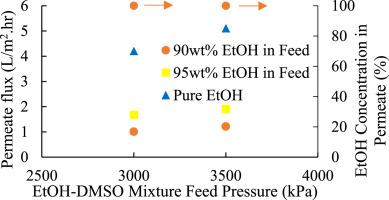当前位置:
X-MOL 学术
›
J. Membr. Sci.
›
论文详情
Our official English website, www.x-mol.net, welcomes your
feedback! (Note: you will need to create a separate account there.)
Organic solvent mixture separation during reverse osmosis and nanofiltration by a perfluorodioxole copolymer membrane
Journal of Membrane Science ( IF 8.4 ) Pub Date : 2021-01-01 , DOI: 10.1016/j.memsci.2020.118663 John Chau , Kamalesh K. Sirkar
Journal of Membrane Science ( IF 8.4 ) Pub Date : 2021-01-01 , DOI: 10.1016/j.memsci.2020.118663 John Chau , Kamalesh K. Sirkar

|
Abstract Highly selective separation of one organic solvent from its mixture with another organic solvent by reverse osmosis will be very useful. Using a 1.67 μm thick film of a particular variety of a glassy amorphous copolymer, perfluoro-2,2-dimethyl-1,3-dioxole copolymerized with tetrafluoroethylene, (PDD-TFE), supported on an e-PTFE support, organic solvent reverse osmosis (OSRO) separations of a number of types of binary organic solvent mixtures were studied. A few studies employed a 0.6 μm thick film of the same copolymer variety designated CMS-7. The feed pressures were varied between 1000 and 5000 kPa; most of the data involved 2500–3500 kPa. Different types of solvent mixtures were studied (similar classes mentioned together): ethanol-NMP, ethanol-dimethylsulfoxide (DMSO); methanol-DMSO, methanol-NMP; toluene-methanol, toluene-N-Methyl-2-pyrrolidone (NMP), toluene-dimethylformamide (DMF); heptane-dodecane; heptane-ethanol. In quite a few cases, a pure solvent was obtained as permeate; the permeate flux could be as much as 3.5 L/m2-hr depending on the feed composition and pressure. Since this behavior is unusual in reverse osmosis, mixture sorption studies were implemented. Mixture sorption data of various mixtures in the copolymer show exclusive sorption by the species showing up as the pure permeate under certain conditions. These and other observed OSRO permeation rate and sorption behavior in the perfluoro-copolymers explain the basis for such extraordinary selectivity for quite a few systems. To illustrate OSRO-facilitated solvent-exchange in organic solvent nanofiltration, studies were carried out also to retain the dye Oil Blue N using the following binary solvent mixtures: toluene-NMP; methanol-NMP. These and other potential applications of highly selective OSRO have been discussed.
中文翻译:

全氟二氧戊环共聚物膜在反渗透和纳滤过程中分离有机溶剂混合物
摘要 通过反渗透从一种有机溶剂与另一种有机溶剂的混合物中进行高选择性分离将非常有用。使用 1.67 μm 厚的特定种类玻璃状无定形共聚物薄膜,全氟-2,2-二甲基-1,3-二氧杂环戊二烯与四氟乙烯共聚,(PDD-TFE),支撑在 e-PTFE 载体上,有机溶剂反向研究了多种类型的二元有机溶剂混合物的渗透 (OSRO) 分离。一些研究采用了 0.6 μm 厚的薄膜,该薄膜由指定为 CMS-7 的相同共聚物品种制成。进料压力在 1000 到 5000 kPa 之间变化;大多数数据涉及 2500-3500 kPa。研究了不同类型的溶剂混合物(一起提到的相似类别):乙醇-NMP、乙醇-二甲亚砜 (DMSO);甲醇-DMSO、甲醇-NMP;甲苯-甲醇,甲苯-N-甲基-2-吡咯烷酮(NMP)、甲苯-二甲基甲酰胺(DMF);庚烷十二烷;庚烷-乙醇。在相当多的情况下,以渗透物形式获得纯溶剂;取决于进料成分和压力,渗透通量可能高达 3.5 L/m2-hr。由于这种行为在反渗透中是不寻常的,因此实施了混合物吸附研究。共聚物中各种混合物的混合物吸附数据显示了在某些条件下作为纯渗透物出现的物质的排他性吸附。这些和其他观察到的 OSRO 渗透率和全氟共聚物中的吸附行为解释了对相当多的系统具有如此非凡的选择性的基础。为了说明有机溶剂纳滤中 OSRO 促进的溶剂交换,还进行了研究以使用以下二元溶剂混合物保留染料油蓝 N:甲苯-NMP;甲醇-NMP。已经讨论了高选择性 OSRO 的这些和其他潜在应用。
更新日期:2021-01-01
中文翻译:

全氟二氧戊环共聚物膜在反渗透和纳滤过程中分离有机溶剂混合物
摘要 通过反渗透从一种有机溶剂与另一种有机溶剂的混合物中进行高选择性分离将非常有用。使用 1.67 μm 厚的特定种类玻璃状无定形共聚物薄膜,全氟-2,2-二甲基-1,3-二氧杂环戊二烯与四氟乙烯共聚,(PDD-TFE),支撑在 e-PTFE 载体上,有机溶剂反向研究了多种类型的二元有机溶剂混合物的渗透 (OSRO) 分离。一些研究采用了 0.6 μm 厚的薄膜,该薄膜由指定为 CMS-7 的相同共聚物品种制成。进料压力在 1000 到 5000 kPa 之间变化;大多数数据涉及 2500-3500 kPa。研究了不同类型的溶剂混合物(一起提到的相似类别):乙醇-NMP、乙醇-二甲亚砜 (DMSO);甲醇-DMSO、甲醇-NMP;甲苯-甲醇,甲苯-N-甲基-2-吡咯烷酮(NMP)、甲苯-二甲基甲酰胺(DMF);庚烷十二烷;庚烷-乙醇。在相当多的情况下,以渗透物形式获得纯溶剂;取决于进料成分和压力,渗透通量可能高达 3.5 L/m2-hr。由于这种行为在反渗透中是不寻常的,因此实施了混合物吸附研究。共聚物中各种混合物的混合物吸附数据显示了在某些条件下作为纯渗透物出现的物质的排他性吸附。这些和其他观察到的 OSRO 渗透率和全氟共聚物中的吸附行为解释了对相当多的系统具有如此非凡的选择性的基础。为了说明有机溶剂纳滤中 OSRO 促进的溶剂交换,还进行了研究以使用以下二元溶剂混合物保留染料油蓝 N:甲苯-NMP;甲醇-NMP。已经讨论了高选择性 OSRO 的这些和其他潜在应用。











































 京公网安备 11010802027423号
京公网安备 11010802027423号